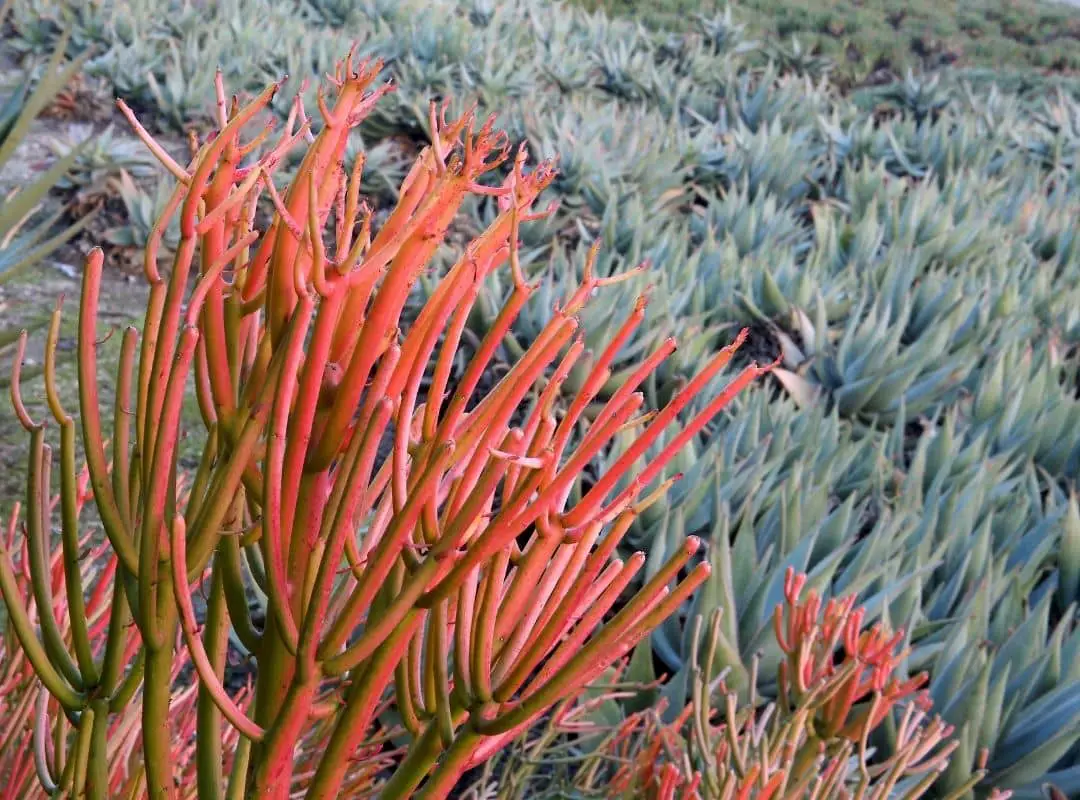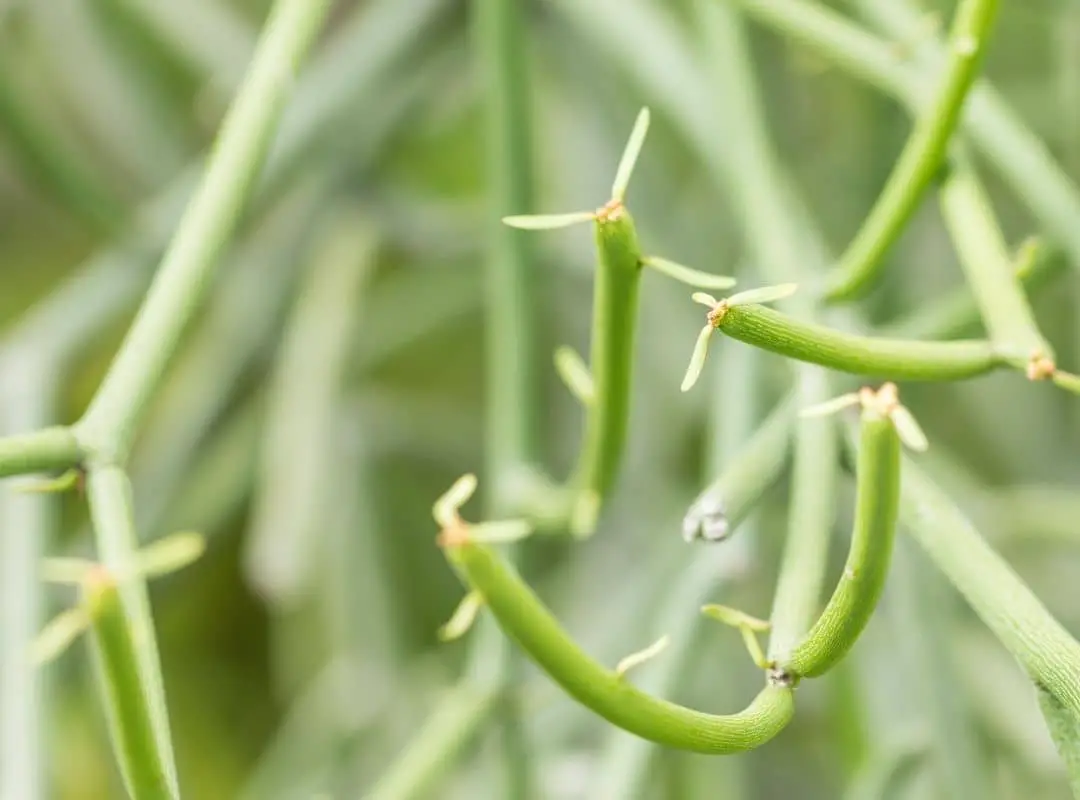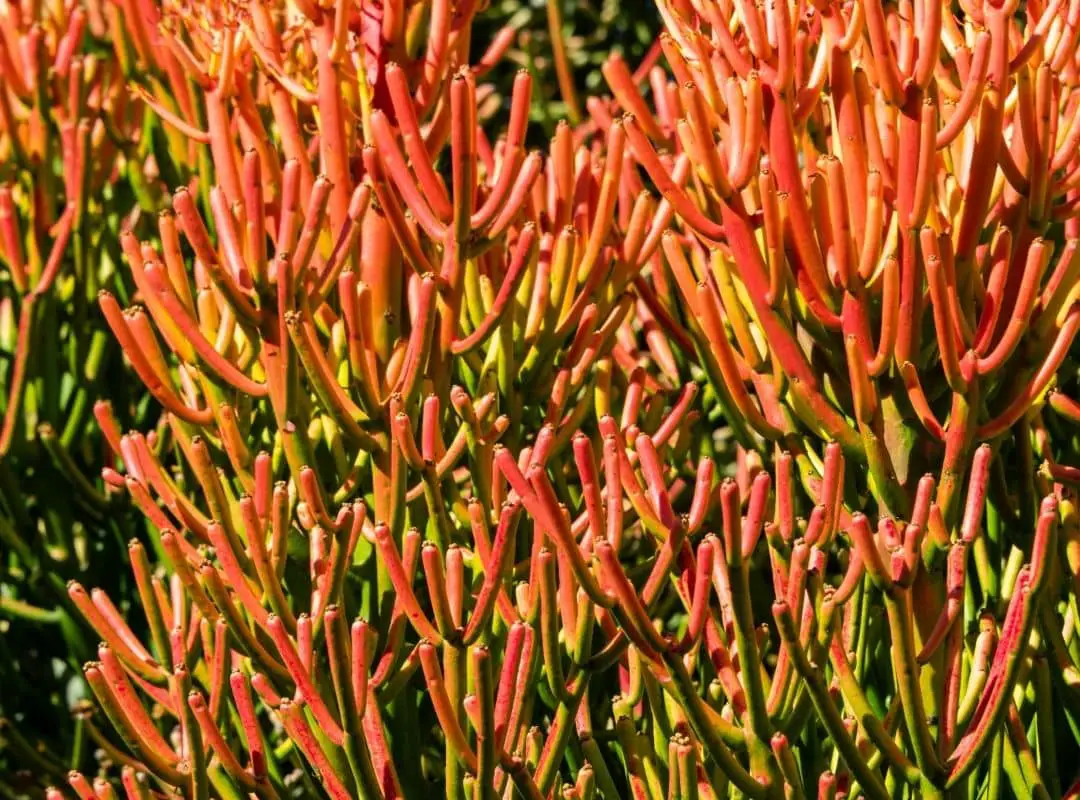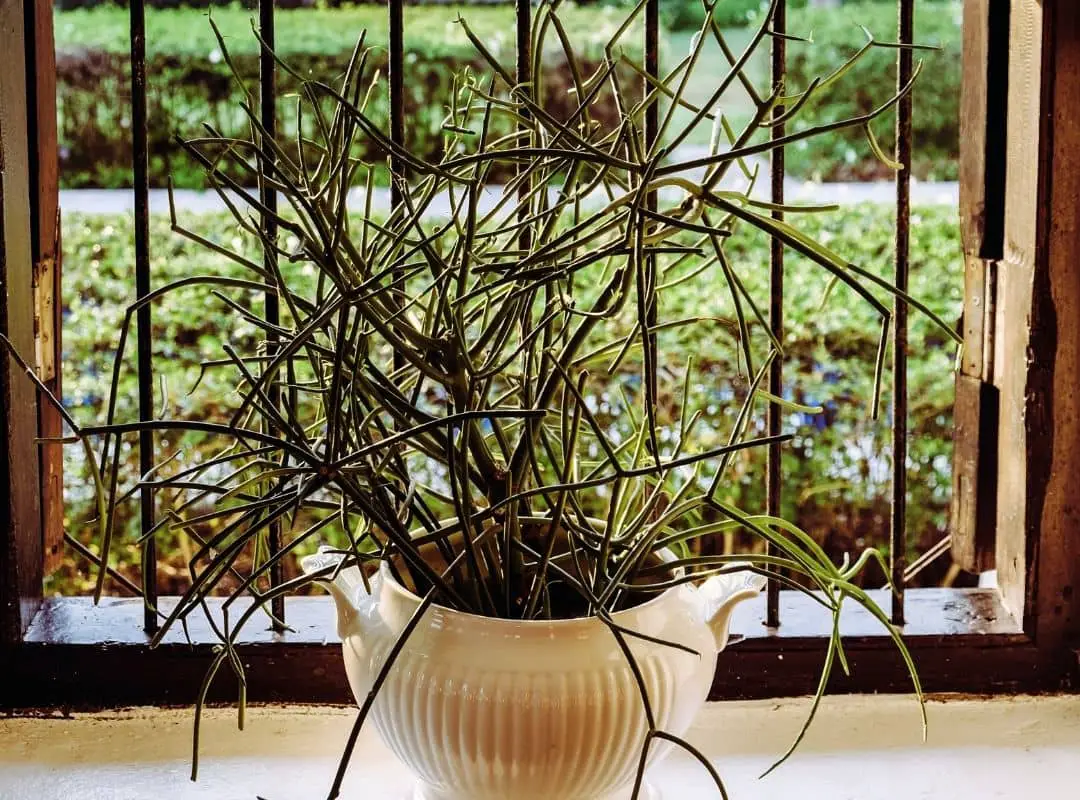Fire sticks plant (Euphorbia tirucalli) is popular in northeastern, northern, and southern Africa. They can also be common to other areas of the continent such as Arabian Peninsula.
Popular common names for Euphorbia Tirucalli are Sticks on Fire (Fire Sticks), Pencil Cactus, Finger plant, Indian tree spurge, and Pencil Tree . Family of the Euphorbia tirucalli is Euphorbiaceae. As you can understand, these plants are simply not cacti species, despite the general belief about them.
Sticks on Fire (Fire Sticks) is a fast growing and spreading plant which is blooming in the spring. It develops slender segmented stems that when new carry tiny leaves that fast fall off. Gradually branches harden off to a dense woody trunk.
Overall, the structure is amorphous and bushy, but it can be pruned into a more desirable shape. That was one of the strongest latex contributors of all species of Euphorbia and started sharing the same milky white sap.
It is caustic and so plants must be treated with caution to prevent contaminating the eyes. Beware in use where pets and children share the room.
Sticks on Fire (Fire sticks plant) can be lived with poor drainage facilities. Generally, they like to live in sandy, well-drained soil with acidic/ neutral soil pH. you can plant them in coastal areas as they can tolerate salt air.
Euphorbia tirucalli (Fire Sticks) loves full sunlight. But they also survive in partial sunlight . They also like to live in low humidity environments which facilitate better growth of the plant. You can propagation the fire sticks by cutting method.
How do I identify Euphorbia tirucalli / fire sticks plant?

Euphorbia Tirucalli is a shrub-like succulent that has light red, pink, orange, or yellow leaves. It is like living in containers in the garden. Sticks on Fire (Fire sticks plant) is a fast growing and spreading plant which is blooming in the spring.
These plants have yellow color flowers. It develops slender segmented stems that when new carry tiny leaves that fast fall off. Gradually branches harden off to a dense woody trunk.
Overall, the structure is amorphous and bushy, but it can be pruned into a more desirable shape.
| Botanical Name | Ceropegia woodii |
| Common Name | String of hearts, Rosary vine, Chain of hearts, Chinese lantern |
| Plant Type | Succulent, Vine, Evergreen |
| Mature Size | 2-5 cm. tall, 2 – 4 m. wide spread |
| Sun Exposure | Partial Sun |
| Soil Type | Well-drained, Fertile |
| Soil pH | Acidic, Neutral |
| Bloom Time | Summer, Fall |
| Flower Color | White to a pale purplish-red |
| Hardiness Zones | 9 – 12, USA |
| Native Area | Southern Africa |
| Toxicity | Toxic |
How do you take care of Euphorbia tirucalli /fire sticks plant?
Size
Euphorbia tirucalli is growing about 8 feet (2.5 m) feet tall and 5 feet (1.5 m) wide.
Growth
Fire sticks plant is a resilient plant and very common one. Many planters used this one as a houseplant . It is a fast-growing plant.
You should assume a mature height of about 8 feet (2.5m) and 5 feet (1.5m) feet wide, for a reasonably similar sized spread.
Euphorbia tirucalli (Fire sticks plant) have cylindrical and smoothly dented branches with tiny and very slender, pendulous branchlets with a rounded crown shape, just about 8 mm in diameter and glaucous grey-green.
Light Requirement
Light requirement for indoor plants
Sunny window setting is ideal and the best place for this plant. Rotate the plant annually for healthy growth and even color production during the colder months.
Light requirement for outdoor plants
Outdoors, Euphorbia tirucalli could do well with either partial or direct light. The plant will be grown well and color changes will be happen where it gets bright sun exposure on all sides
Temperature and humidity
Though the plant can tolerate temperatures from 25 – 100 degrees Fahrenheit, it actually likes temperatures ranging from 50 – 70degrees Fahrenheit. So, it can live well under room temperature .
Fire sticks plant plant required a low humid environment for its proper growth.
Is it cold hardy?
Yes, Fire sticks plant is a cold hardy plant.
Fire sticks plant is cold hardy, depending on the duration, not much below 30 degrees Fahrenheit.
Zone
The Hardiness zone of Oxalis palmifrons is 10a; -1.1 °C (30 °F) to +1.7 °C (35 °F)
Watering Requirement
Indoor care
You should water Euphorbia tirucalli weekly during the growing season. During the watering, you should pay attention to prevent overwatering and about drainage holes of the containers that will be worked well. Nevertheless root rot can happen.
Outdoor care
It’s good to offer too little water than too much. because Euphorbia tirucalli is a drought resistant plant. One time per month is enough for watering during the growing stage of the Fire sticks plant. But in the winter season the watering requirement is enough for once every couple of months. These drought resistant plants can do very well with only rainwater.
Soil Requirement Type / pH
Generally, Euphorbia tirucalli like to live in sandy, well-drained soil with acidic/ neutral soil pH.
soil requirement of indoor plants
Euphorbia tirucalli like to live in well-drained and around 6.0 pH soil. This condition facilitates the well growth of the plant.
soil requirement of outdoor plants
When planting Euphorbia tirucalli outdoors, you can apply some sunlight or compost to increase aeration and drainage facilities.
Flowering and Fragrance
From September to December the blooming of the Euphorbia tirucalli will happen. Euphorbia tirucalli plants can produce clusters of yellow flowers. These yellow flowers bloom on the end and the inner corners of the short branches. Enhance the process of pollination due to attracting the bees and butterflies.
Blooming takes place When they are ready or mature enough. To inspire blooms, there isn’t so much you can do. Proper treatments and providing necessary facilities facilitate the blooming.

Pot size Potting and Repotting
When growing Fire sticks plant in a jar, it’s better to use an unglazed clay pot that helps excess moisture to evaporate through its walls. Often, make sure there are enough drainage holes in the cup.
The plant can survive being a little crowded in its pot. Repotting should be done after overcrowding will take place. Before repotting, make sure the soil is dry. Then, remove the plant carefully, from the jar and remove the dirt particles. You should remove dead, shriveled, black and rotting roots . Finally, the plant should place in the new jar and fill it with a new and fresh potting mix. Remember to water the plant only after one week of repotting.
Fruits and seeds
From September to December the producing fruits of the Fire sticks plant will happen. The fruits are a type of pale-green capsules, each with a pink color and huge quantities of light hair that are smooth, up to 12 mm in size.
Fire sticks plant produce soft and brown color seed each with about 5 mm with a white line around the hilum.
Where to Plant
Fire sticks plant like to live under full sun to part sun, with dappled shadow. They like to live in low humidity environments which facilitate better growth of the plant.
Indoors in a sunshine place, or raised outdoors in a house will suit. Fire sticks plant is a frost tender plant. So, it should keep indoors during the winter. The place of Fire sticks plant lives may be changed according to the palace which you are living in.

Fertilizer and time of year
Using fertilizer for Indoor plants
The Fire sticks plant feed can be treated seasonally with a controlled-release fertilizer or can be used weekly with weak liquid houseplant food. A 20-20-20 fertilizer helps mature plants grow well. With a lower nitrogen rating, younger plants do better.
Using fertilizer for outdoor plants
If you keep a worm composting bin, you will find that all the nourishment your ET wants is provided yearly by a sheet of worm compost or worm castings spread over the surface of the soil.
Dormancy
Fire sticks plant is a winter dormant plant.
Other plants Pairs Well With
Aeonium ‘Kiwi’ paired well with Fire sticks plant.
Can be toxic to pets
Fire sticks plant can be toxic to both humans and pets (cats, dogs). Skin irritations can happen due to milky sap excretes. Eyes and nose can be irritating due to handling the Fire sticks plant. Ingestion can cause moderate to extreme inflammation to the mouth area and GI tract.
Common bugs and illness issues
Meal bugs
Most of the time, Meal bugs is a common indoor pests. They are eating leaves and stems as their feeds. Meal bugs are short and they have no wings. They have an oval shape body, and translucent, cotton like covering of overlapping soft plates.
Look for white colonies on plant leaves that grow as sticky clusters. Honeydew that may lead to dark/black color mold, a parasitic fungus that covers plant leaves and avoids vital sunlight, is secreted by Mealybugs.
Spider mites
Most of the time, Spider mites can be seen in the indoor plants.spider mites partially visible to the naked eye and behave as tiny pepper like flecks of yellow, red-green on plants.
A low number of pests (limited colonies) do not affect the plant but large colonies can cause stippling and bronzing of leaves. Otherwise, large colonies can cause leaves to turn yellow and drop off. Sometimes it can lead to the death of the plants.
Aphids
Most of the time, aphids can be seen on newly growing plants and they are a popular type of houseplant insect. These smooth pests suck plant sap, causing ripened, discolored leaves and underdeveloped plant growth. Purple, pink, white or pale green color bugs can be seen.
Honeydew can be secreted by aphids that can lead to sooty mold that can destroy pants with toxins that can damage plants more. A low number of pests (limited colonies) do not affect the plant but large colonies can cause harm.
Brown leaves
The much more common symptom of brown leaves on Euphorbia tirucalli is sun damage. Although Fire sticks plant can handle full sunlight, some adverse climatic conditions will cause damage to leaves as sun burns. These sunburns do not affect internally,but with time it can have an adverse effect. Provide further cover or shade during intense heat waves to avoid brown spots.
Shriveled leaves
Shriveled leaves are formed due to underwatering. After facing this problem leaves look shriveled and dried up. If you touch the leaf you feel smooth and deflated.
If you see these conditions on leaves, you must water the plant. Offer the plant a strong drink of water and it should perk up instantly, normally within a day or two.
Mushy translucent leaves
Mushy translucent leaves are formed due to overwatering. After Mushy translucent leaves are formed, the plant lives not well and feels soft.
This is typically signalling you are overwatering your farm. Cut down on irrigation to encourage the plant to dry out and heal from so much water.
Special Care tips
Frequent pruning is not needed for stick cactus. If it starts getting too high, you can trim any of the branches to cut it down to a more manageable shape.
How do you propagate a Euphorbia tirucalli /fire plant?
- Stem cutting is the easiest way of propagate.
- ·cutting can be obtained from the stem. Then it keeps dry for a few weeks before callous on the cut end has been grown.
- If you can speed up the process, the end of the cut should be dip into a rooting hormone. This step is not essential.
- Till cuttings are dried, it should be stuck in a potting mix which is well drained.
- When rooting, keep away from direct sunlight to avoid burns. A few days, water the soil or when it feels dry.
- You’ll find fresh roots developing after about two weeks or so. After 4-6 weeks completely rooting should happen. Then you can see new growth from the top/ the sides along the stem.

Euphorbia tirucalli /fire plant plant benefits
Euphorbia tirucalli has recently become popular as an ornamental plant. It can be used to decorate offices or homes. Because of its beauty and low maintenance it will be used as an ornamental plant.
That one was confirmed the latex of Euphorbia tirucalli made of petroleum like hydrocarbons mostly C30triterpenoids, that on cracking produce high-octane gasoline. ·
Euphorbia tirucalli is identified for having hydrocarbon polymers that are used for making rubber substitutes.
Euphorbia tirucalli can be used for afforestation and reforestation in semi-arid areas due to drought resistant ability of the plant. So, it facilitates soil conservation. On the other hand it can be used as a soil cover. Euphorbia tirucalli having the ability of pesticidal features against aphids, mosquitoes and some kind of microorganisms.
Acetone can be extracted from Euphorbia tirucalli ’s stem which can be inhibiting the microorganisms activities.
Is Euphorbia tirucalli /fire plant an indoor plant?
Euphorbia tirucalli can be lived indoors as well as outdoors. However, the plant grows very well with lots of sunshine, so make sure to have plenty of daylight for it to flourish, whether you grow it indoors or out.
Frost tolerance
Euphorbia tirucalli is not a really frost hardy plant. This plant can be tolerated against mild frost during a short time period but it cannot be tolerated for a long time period on above condition. Euphorbia tirucalli can be grown well over 30 degrees Fahrenheit (-1.1 degrees Celsius).
Credit to : Summer Rayne Oakes
Read more: Sedum Rubrotinctum (Jelly Bean Succulent) Care | Full Guide


